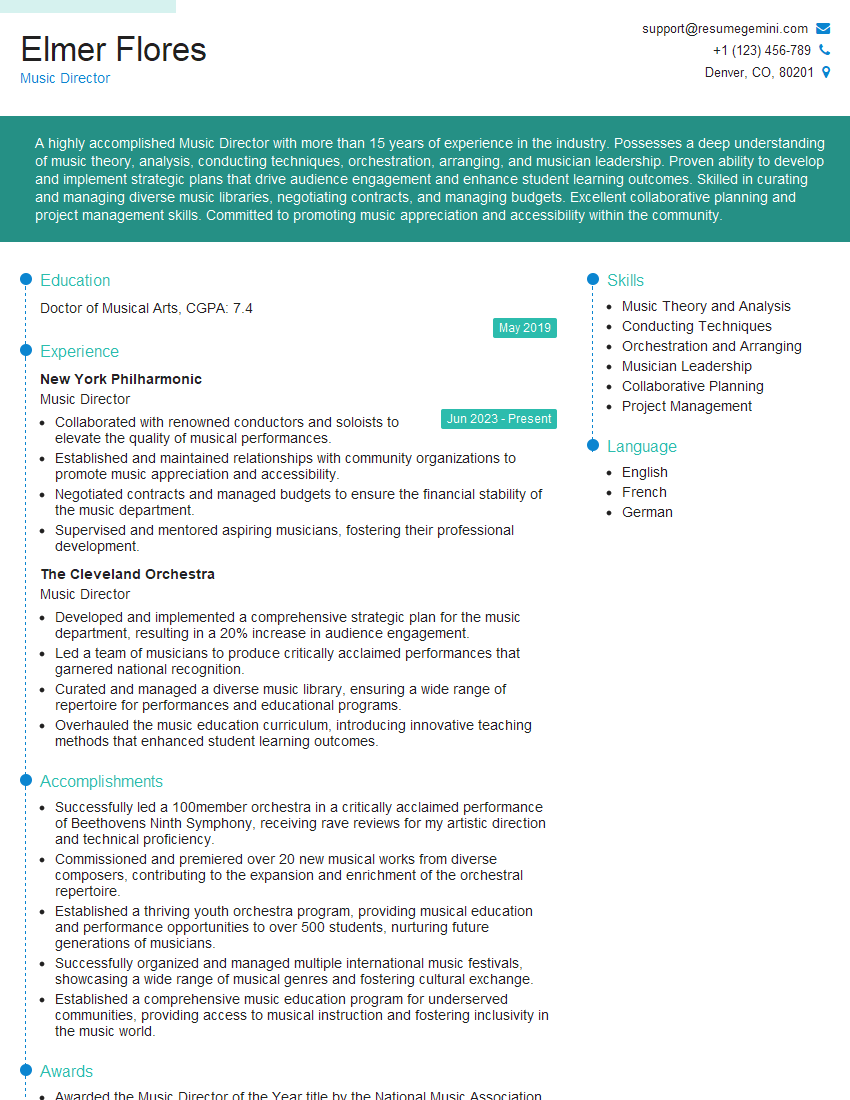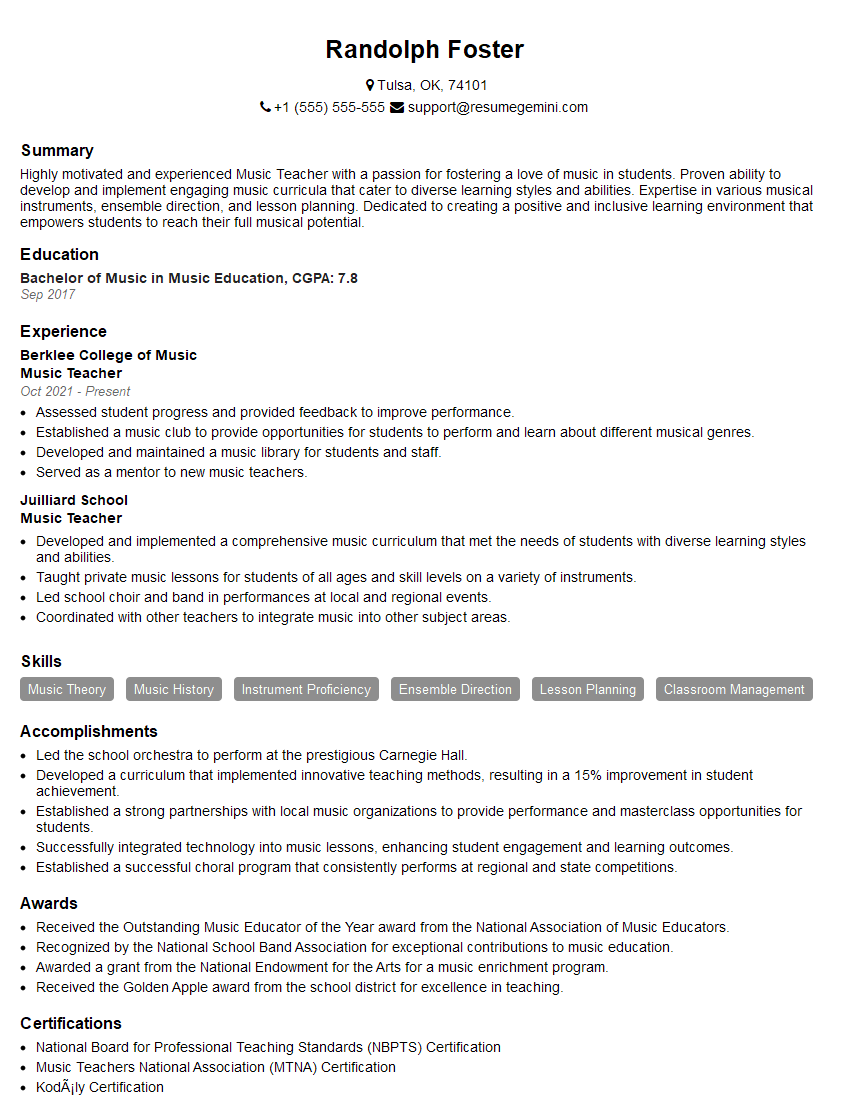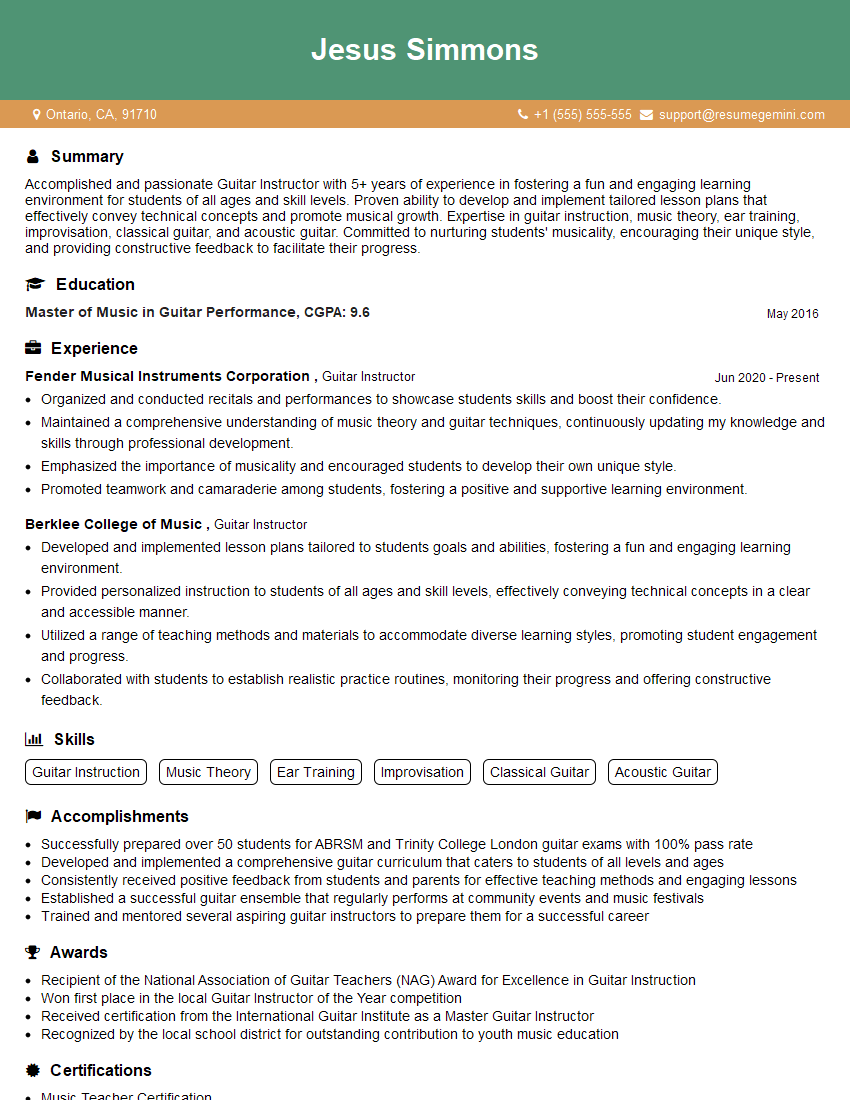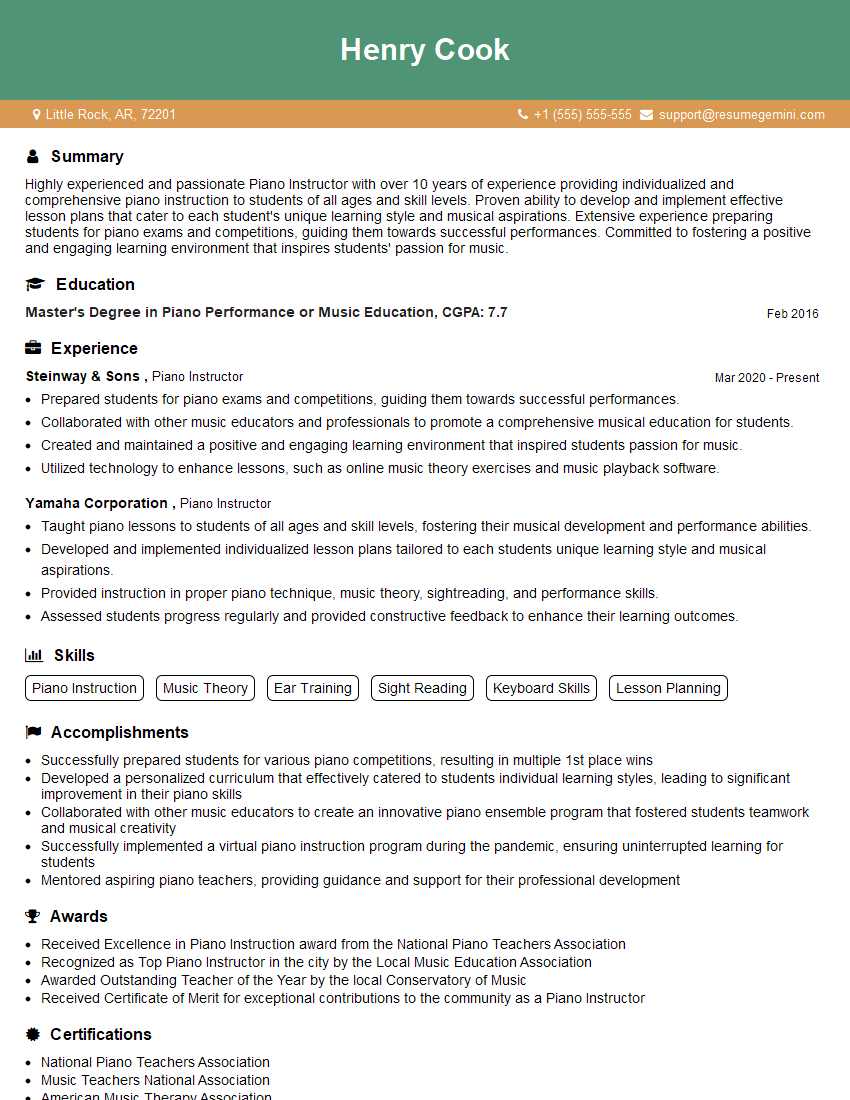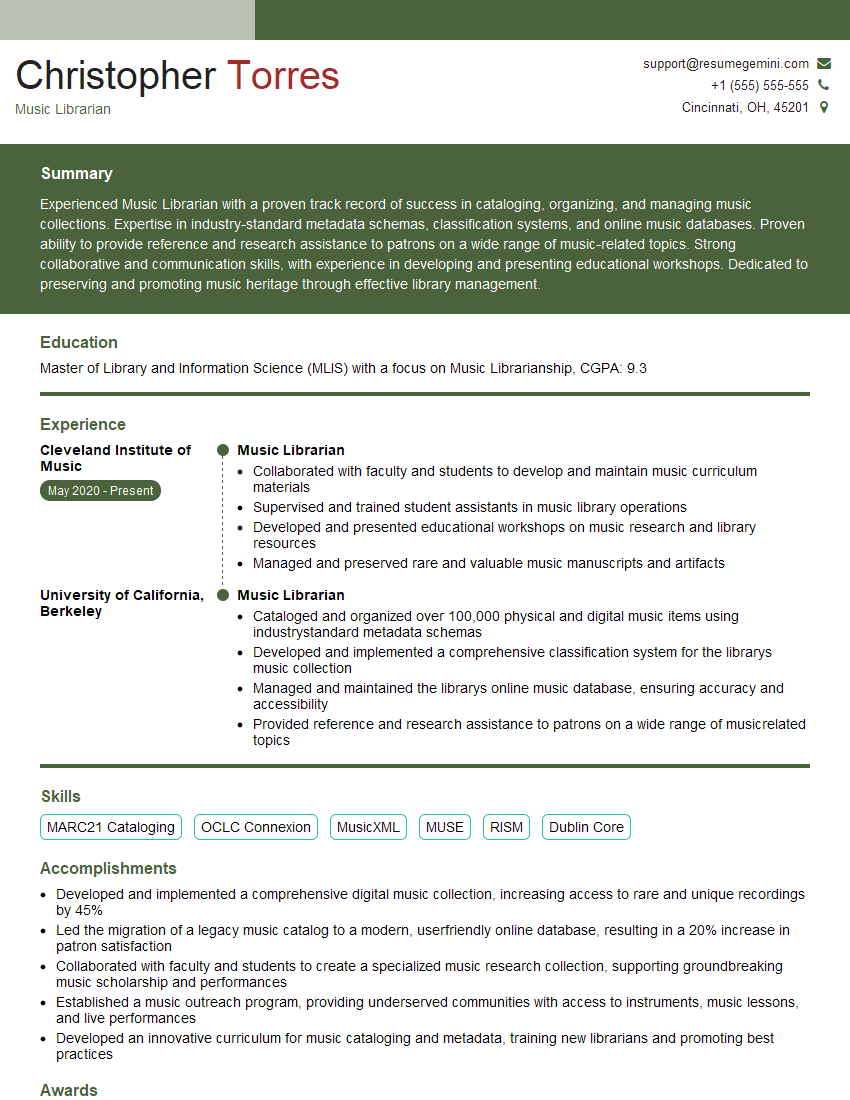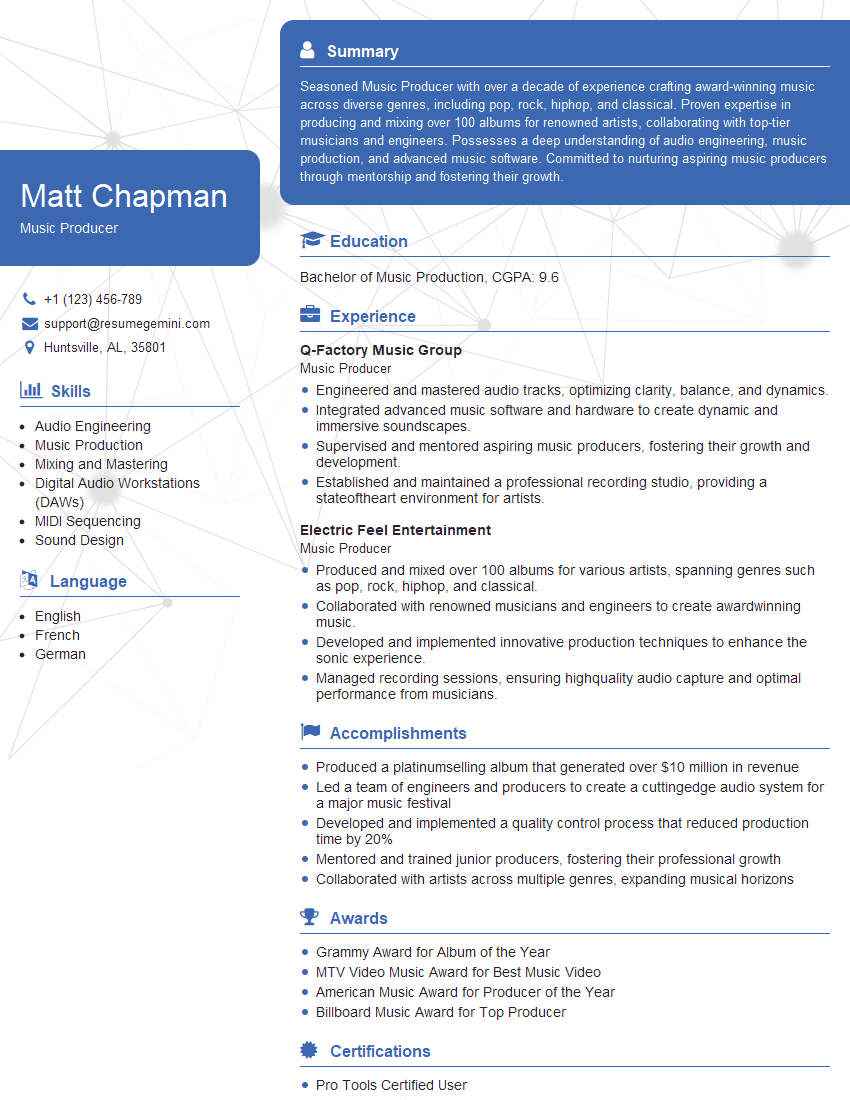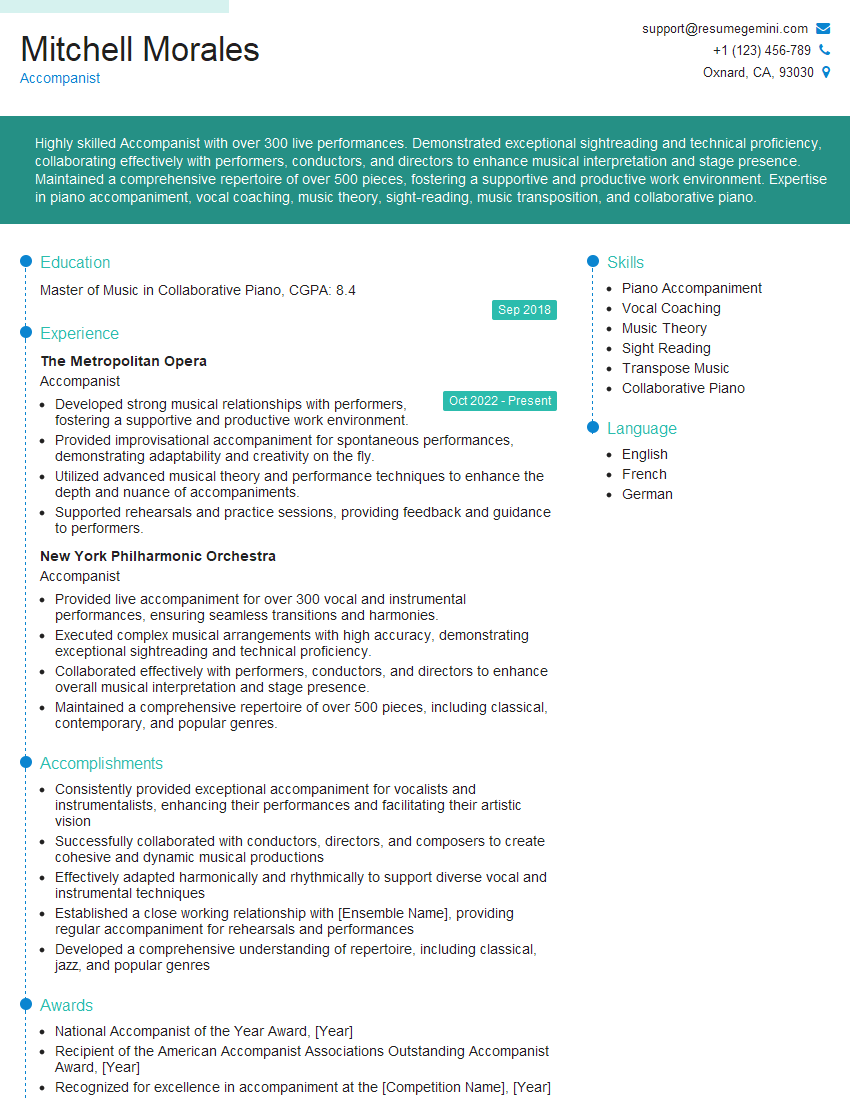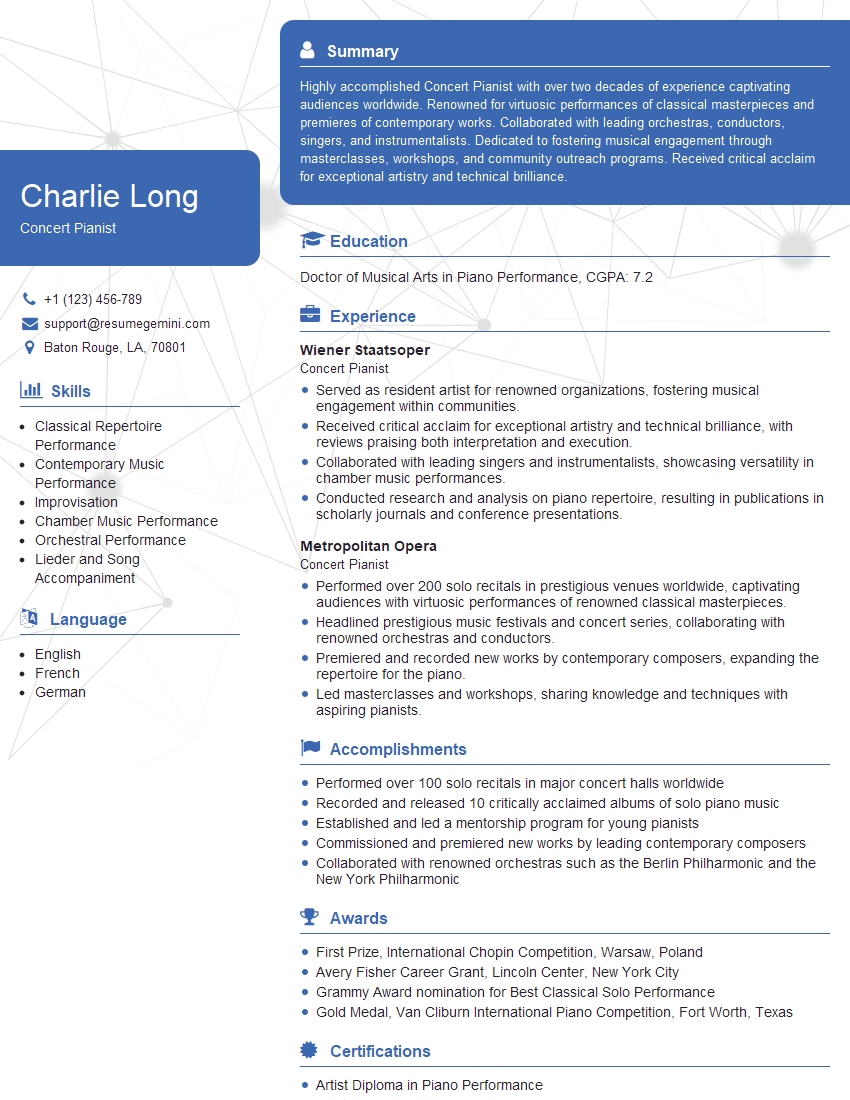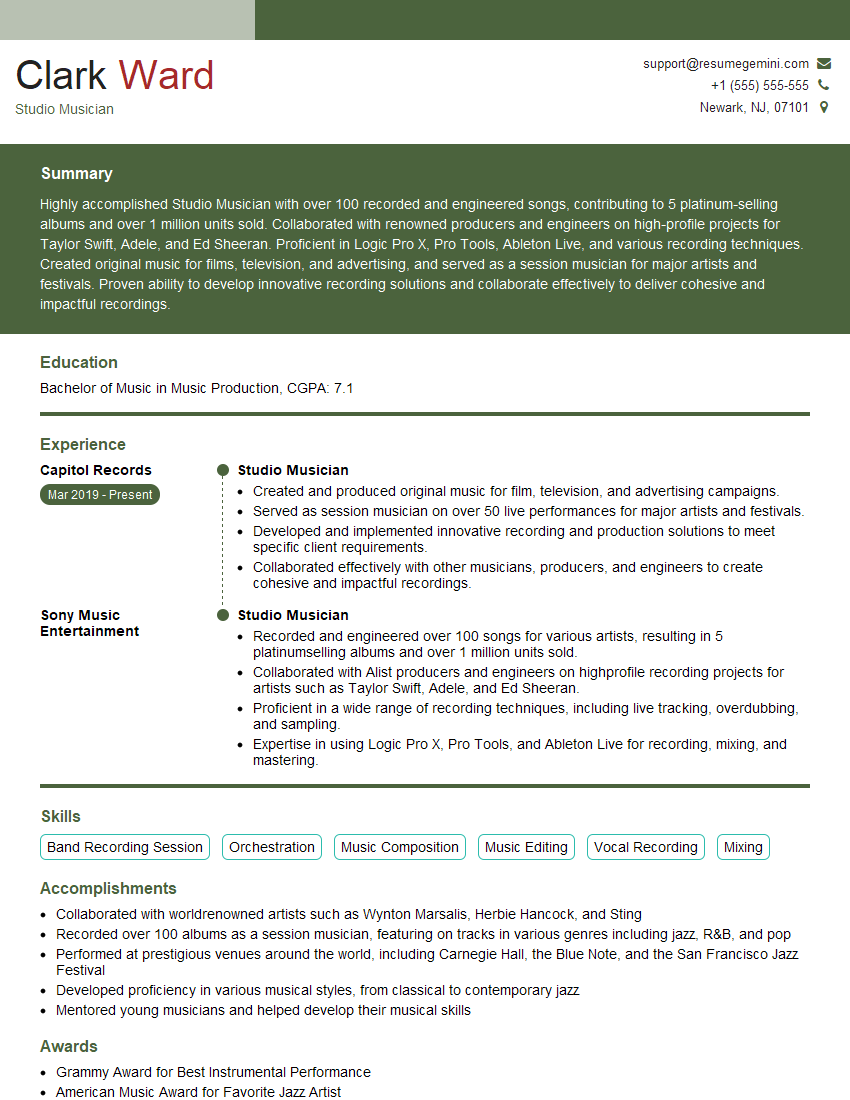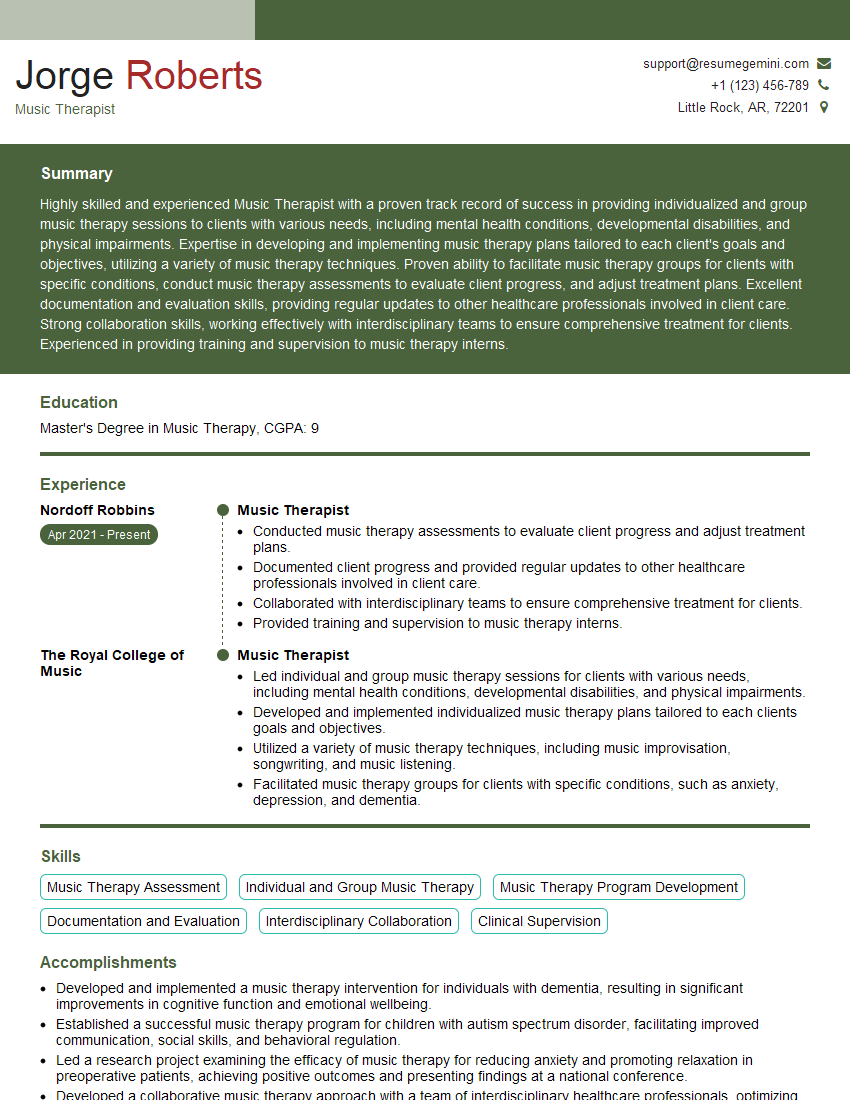Interviews are more than just a Q&A session—they’re a chance to prove your worth. This blog dives into essential Piano and Guitar Skills interview questions and expert tips to help you align your answers with what hiring managers are looking for. Start preparing to shine!
Questions Asked in Piano and Guitar Skills Interview
Q 1. Explain the difference between major and minor scales.
The difference between major and minor scales lies primarily in the intervals between their notes. Major scales are characterized by a bright, cheerful sound, while minor scales evoke a darker, more melancholic feeling. This difference stems from the placement of the third degree of the scale.
A major scale has a major third (four semitones) between the first and third degree, while a minor scale has a minor third (three semitones) between the same notes. For example, in the C major scale (C-D-E-F-G-A-B-C), the interval between C and E is a major third. In the C natural minor scale (C-D-Eb-F-G-Ab-Bb-C), the interval between C and Eb is a minor third.
Think of it like this: a major scale is like a sunny day, while a minor scale is like a cloudy evening. This difference in the third degree drastically alters the overall mood and character of a melody or chord progression.
- Major Scale Formula: W-W-H-W-W-W-H (W = whole step, H = half step)
- Natural Minor Scale Formula: W-H-W-W-H-W-W
Q 2. Describe your experience with different guitar tunings (e.g., standard, drop D, open G).
My experience with various guitar tunings extends beyond standard tuning. I’m proficient in drop D, open G, and several others used in specific genres. Standard tuning (EADGBe) is my foundation, but I find alternative tunings invaluable for achieving different sonic textures and playing styles.
Standard Tuning (EADGBe): This is the most common tuning and serves as the basis for a wide array of musical styles. Its versatility makes it ideal for learning and exploring.
Drop D Tuning (DADGBe): Dropping the low E string down to D significantly alters the feel and tone, adding a heavier, more powerful sound. This tuning is very popular in rock and metal genres, providing heavier riffs and easier access to lower notes.
Open G Tuning (DGDGBD): This tuning is commonly used in folk, blues, and bluegrass styles. It creates open chord voicings that allow for quick chord changes and fingerpicking patterns, making it perfect for slide guitar techniques.
The choice of tuning often dictates the song’s character and influences the overall composition. I frequently experiment with tunings to enhance the emotional impact and expressive potential of my guitar playing.
Q 3. What are your preferred methods for sight-reading music?
My sight-reading method involves a multi-faceted approach focusing on understanding the musical notation’s structure and applying practiced patterns. I begin by quickly scanning the piece to understand its overall form—melody, harmony, and rhythm. I then systematically analyze the individual measures and sections.
My practice includes regular drills focusing on rhythm and interval recognition. I also work on memorizing common chord shapes and scales to expedite recognition. The key is to blend technical skills (note reading) with musical comprehension (understanding the phrasing and expression intended by the composer).
When encountering a difficult passage, I break it down into smaller, manageable sections, practicing them slowly and methodically until fluency is achieved. I then gradually increase the tempo as accuracy improves. Regular practice is key to improving sight-reading proficiency.
Q 4. How do you approach learning a new piece of music on the piano?
Learning a new piano piece is a structured process. First, I obtain a clear understanding of the piece’s overall structure and harmonic progression. This often involves analyzing the score to identify key changes, melodic motifs, and rhythmic patterns.
Next, I begin practicing slowly, focusing on accuracy and proper fingering. I break the piece into smaller sections, tackling challenging passages individually. I use various practice techniques, such as isolating tricky sections and repeating them until mastery is achieved.
Once I have a solid grasp of the technical aspects, I shift focus to the musical interpretation—dynamics, phrasing, and articulation. I try to incorporate my artistic sensibility to convey the composer’s intent and add my personal expression to the performance.
Throughout the learning process, regular recordings of my practice sessions allow me to assess my progress and identify areas requiring further attention. The goal is not just accurate playing, but also a nuanced and expressive interpretation of the music.
Q 5. Discuss your experience with improvisation on the guitar.
My improvisation on the guitar is deeply rooted in my understanding of music theory and my extensive experience with various musical styles. I approach improvisation by focusing on melodic ideas, chord progressions, and rhythmic variations.
My improvisations often draw upon scales, modes, and arpeggios related to the underlying chord changes. I utilize techniques like blues scales, pentatonic scales, and chromaticism depending on the musical context. I also emphasize the use of rhythmic syncopation and phrasing to create interesting melodic contours.
I frequently incorporate elements from different genres, such as blues, jazz, and rock, depending on the desired mood and feeling. Listening to other improvisers is crucial for my development. It helps me absorb different approaches and styles, constantly expanding my vocabulary and creativity.
Q 6. Explain your understanding of music theory, including chords, intervals, and rhythm.
My understanding of music theory is comprehensive and forms the foundation of my musical skills. It encompasses several key elements:
- Chords: I understand chord structures, voicings, and progressions. I’m proficient in recognizing and constructing major, minor, augmented, diminished, and seventh chords, among others. I understand how chord changes create harmonic movement and drive musical emotion.
- Intervals: I can identify and utilize intervals (distance between two notes) to build scales, chords, and melodies. I understand the importance of consonant and dissonant intervals in creating musical tension and release.
- Rhythm: I possess a strong rhythmic understanding, including time signatures, note values, rests, and syncopation. Accurate rhythmic execution is crucial for precise and expressive performances.
This theoretical knowledge allows me to analyze, interpret, and create music effectively, whether composing, improvising, or performing existing compositions.
Q 7. Describe your experience with different musical styles (e.g., classical, jazz, rock).
My musical experience spans across diverse styles, including classical, jazz, and rock. This breadth of experience enriches my understanding and playing across various instruments.
Classical Music: My classical training on the piano instilled in me a strong foundation in music theory, technique, and interpretation. This background helps me approach any genre with a strong sense of structure and musicality.
Jazz Music: I’ve explored jazz improvisation techniques on both piano and guitar, focusing on harmony, rhythm, and melodic improvisation over chord changes. My appreciation of jazz lies in its freedom and spontaneity.
Rock Music: My experience with rock music, primarily on guitar, has broadened my understanding of rhythm, powerful chord progressions, and dynamic expression. This style has allowed me to develop a more assertive and energetic playing style.
This diversified experience allows for a versatile approach to music, making me comfortable playing and adapting to various musical contexts.
Q 8. How do you handle performance anxiety?
Performance anxiety is a common challenge for musicians. I’ve learned to manage it through a multi-pronged approach focusing on preparation, mental techniques, and mindful practice. Thorough preparation is key; knowing the piece inside and out reduces the fear of forgetting. This means practicing not just the notes, but also the phrasing, dynamics, and emotional intent.
Mentally, I utilize visualization techniques, imagining myself performing successfully. Deep breathing exercises before a performance help calm my nerves. Finally, mindful practice helps to build confidence and resilience. Instead of focusing on perfection, I focus on the process of playing, celebrating small victories and learning from mistakes. I’ve found that consistent practice in performance-like settings – recording myself, playing for friends – gradually desensitizes me to the pressure.
Q 9. What software or technology do you use for music production or notation?
For music production, I primarily use Logic Pro X. Its intuitive interface and vast array of virtual instruments and effects allow me to create high-quality recordings. For notation, I use Sibelius, which is excellent for creating professional-looking scores. It allows for intricate detail, accurate engraving, and easy sharing of scores with collaborators. I’ve also experimented with Dorico, which offers some advantages in terms of workflow and automation, particularly for large projects. Choosing between these depends heavily on the project’s demands; Sibelius is my go-to for most tasks.
Q 10. Describe your experience teaching music to students of different ages and skill levels.
Teaching music to students of all ages and abilities is incredibly rewarding. My approach is highly individualized. With younger students (e.g., ages 5-10), I focus on building a foundation in music theory and basic technique using playful activities and engaging games. For example, learning rhythm might involve clapping games or creating simple melodies with percussion instruments before moving to the piano or guitar. Older students (10+) benefit from a more structured curriculum encompassing more advanced theory and performance techniques. I adapt my teaching methods depending on the student’s learning style, whether they are visual, auditory or kinesthetic learners. For example, I might use different teaching methods for a student that struggles with the technical aspect of the instrument and a student struggling with the musical comprehension. I always emphasize the importance of musicality and expression over technical proficiency alone. Regular performance opportunities, whether it’s a recital or a simple jam session, are integral to the learning process and helps the student gain confidence.
Q 11. How do you maintain your instrument and keep it in optimal playing condition?
Maintaining my instruments is crucial for optimal playability and longevity. For my piano, regular tuning is essential – typically every six months to a year, depending on the environment. I also keep it clean, using a slightly damp cloth to wipe the keys and avoid harsh chemicals. For my guitar, I regularly check the string tension and intonation, adjusting as needed. I change strings regularly, typically every few months, depending on playing frequency. I keep it in a stable environment away from direct sunlight and temperature extremes. Proper humidity control is also vital, preventing warping of the wood. Using a humidifier during dry seasons can prevent cracks and other damage. Regular inspections for any signs of wear or damage, promptly addressing any issues, are crucial for maintaining my instruments in optimal playing condition.
Q 12. What is your approach to practicing scales and arpeggios?
Practicing scales and arpeggios is fundamental for developing technique and musicality. My approach focuses on mindful and efficient practice, avoiding mindless repetition. I work on scales in different octaves, exploring various articulations (e.g., legato, staccato) and dynamics. For arpeggios, I focus on smooth, even voicing and accurate rhythm. I utilize intervallic practice, focusing on the relationships between notes within the scales and arpeggios. This helps improve finger independence and enhances my understanding of harmony. Hand coordination exercises, such as playing scales and arpeggios in contrary motion or octaves are crucial to improve technical skills. I always record myself practicing to identify and correct areas needing improvement. I often incorporate scales and arpeggios into improvisation exercises, applying them in musical contexts to develop musicality.
Q 13. Explain your understanding of music harmony and voice leading.
Music harmony is the foundation of composition and arranging. It’s about understanding how chords and melodies interact to create a coherent musical structure. Voice leading involves the smooth and logical progression of individual melodic lines within a harmonic context. Understanding functional harmony (tonic, dominant, subdominant) and chord progressions is essential. I regularly analyze scores from different composers to deepen my understanding of harmonic language, including the use of inversions, seventh chords, and secondary dominants. Voice leading focuses on avoiding awkward leaps or parallel fifths and octaves. Smooth voice leading contributes to a more pleasing and logical sound. For example, a smooth progression within a cadence is essential to create a satisfying resolution.
Q 14. Describe your experience with ensemble playing.
Ensemble playing is a highly collaborative process demanding precise coordination and mutual respect. I’ve played in various ensembles, including chamber groups and orchestras. The experience has significantly improved my listening skills and my understanding of musical balance and blend. It taught me the importance of timing, intonation, and dynamics within a larger musical context. Ensemble playing involves actively listening to other musicians, adjusting one’s own playing accordingly, while retaining individual musicality. A collaborative spirit and open communication within an ensemble are crucial for a harmonious and successful performance. For example, the ability to adapt one’s playing in reaction to the dynamic changes of other instruments is crucial in developing a good sense of ensemble playing.
Q 15. How do you adapt your teaching style to meet the needs of individual students?
Adapting my teaching style is crucial for effective learning. I believe in a personalized approach, understanding that each student learns differently. My initial assessment involves understanding their musical background, learning style (visual, auditory, kinesthetic), goals (performance, composition, theory), and current skill level.
For beginners, I focus on building a strong foundation in basic techniques, gradually introducing more complex concepts. I might use games and simple melodies for younger learners, while adults might appreciate a more structured approach with specific exercises tailored to their goals. For intermediate and advanced students, I collaborate on repertoire selection, focusing on challenges that push their technical and musical boundaries. Regular feedback and adjustments to the learning plan are key; I use a combination of observation, listening to their playing, and discussing their progress to fine-tune my approach.
For instance, a student struggling with rhythm might benefit from rhythmic dictation exercises and clapping games, while another struggling with dexterity might require targeted finger exercises and scales. The key is flexibility and responsiveness to individual needs.
Career Expert Tips:
- Ace those interviews! Prepare effectively by reviewing the Top 50 Most Common Interview Questions on ResumeGemini.
- Navigate your job search with confidence! Explore a wide range of Career Tips on ResumeGemini. Learn about common challenges and recommendations to overcome them.
- Craft the perfect resume! Master the Art of Resume Writing with ResumeGemini’s guide. Showcase your unique qualifications and achievements effectively.
- Don’t miss out on holiday savings! Build your dream resume with ResumeGemini’s ATS optimized templates.
Q 16. What are your strengths and weaknesses as a musician?
My strengths lie in my versatility across both piano and guitar, coupled with a solid theoretical understanding of music. I can easily transpose pieces, improvise in various styles, and quickly learn new material. I’m also a patient and communicative teacher, able to break down complex concepts into easily digestible steps. I have a strong understanding of musical history and theory that enriches my teaching and performance.
A weakness I’m actively working on is the ability to balance self-promotion and professional networking with the time dedicated to teaching and performing. The business side of music is sometimes challenging, and I need to develop more effective strategies for marketing my services and increasing my visibility.
Q 17. How do you approach composing or arranging music?
My approach to composition and arrangement starts with an idea – a melody, a rhythmic motif, or even a feeling. I often begin by sketching out my ideas on the piano or guitar, exploring different harmonies and textures. I use notation software (like Sibelius or Finale) to formalize my ideas, refining the melody, harmony, and rhythm. I’m always conscious of the overall form and structure of the piece, ensuring a coherent and satisfying musical journey for the listener.
For arranging, I consider the specific instrumentation and the desired sonic palette. I may start by transcribing a piece for a different ensemble, or I might create a new arrangement from scratch based on a pre-existing melody. I consider dynamics, articulation, and orchestration to create a captivating arrangement. The process involves experimentation, revision, and often, collaboration with other musicians.
Q 18. Explain your understanding of musical form and structure.
Musical form and structure are fundamental to creating coherent and engaging music. Understanding forms like sonata form, rondo form, and theme and variations is essential for both composing and performing. Sonata form, for example, typically includes an exposition (presenting the main themes), a development (exploring the themes harmonically and melodically), and a recapitulation (returning to the main themes). Rondo form features a recurring main theme interspersed with contrasting episodes.
Structure involves considering phrases, sections, and movements. Each section plays a specific role in the overall narrative of the piece. Understanding the function of each section helps in analysing and interpreting music. For instance, a bridge might provide contrast or transition between sections, while a coda might offer a conclusive ending. Analyzing form and structure helps a performer to understand the composer’s intent and present the music effectively.
Q 19. What are some common challenges you face when playing the piano/guitar, and how do you overcome them?
Common challenges I face include maintaining consistent practice habits, overcoming performance anxiety, and refining technical skills. On the piano, achieving consistent evenness in both hands, particularly in fast passages, can be challenging. On the guitar, maintaining accurate intonation and developing finger strength and dexterity are ongoing processes.
To overcome these, I maintain a structured practice routine, focusing on targeted exercises for specific weaknesses. For performance anxiety, I use visualization techniques and regular performance opportunities in low-pressure settings to build confidence. I continuously seek feedback from other musicians and instructors to identify areas for improvement and refine my technique. Regular stretching and proper posture also play a crucial role in preventing injuries and maintaining comfort while playing.
Q 20. Describe your experience with recording music.
My recording experience includes both solo and collaborative projects. I have used various Digital Audio Workstations (DAWs) like Logic Pro X and Ableton Live to record, edit, and mix my own music. This includes multi-tracking individual instruments, layering sounds, and applying effects to achieve the desired sonic quality. I’m comfortable with microphone placement, signal processing, and editing techniques.
I’ve also collaborated with other musicians and engineers in professional studio settings. This experience broadened my understanding of the recording process, from pre-production planning to mastering. I’ve learned about different recording techniques, microphone choices, and the importance of a good listening environment in achieving a high-quality recording. I understand the nuances of different recording formats and the importance of archiving the final product properly.
Q 21. What are your career goals as a musician?
My career goals include establishing myself as a versatile musician and educator. I aim to continue developing my skills on both the piano and guitar, expanding my repertoire and exploring new musical styles. I also aspire to create and release my own original music, both solo and collaborative projects. Teaching remains a core part of my career aspirations; I want to mentor and inspire the next generation of musicians.
Long-term, I envision a career that blends teaching, performing, and composing. I’m also exploring opportunities to collaborate with other artists and explore different avenues within the music industry, such as composing for film or video games. Ultimately, my aim is to make a meaningful contribution to the world of music, whether through teaching, performance, or composition.
Q 22. How do you stay current with trends in music and technology?
Staying current in the ever-evolving worlds of music and technology requires a multifaceted approach. For music trends, I actively engage with various platforms. This includes listening to a broad spectrum of contemporary artists across genres, attending live performances, and participating in online music communities and forums. I also regularly subscribe to music publications and podcasts that focus on industry news and emerging artists. Technology-wise, I remain updated through professional journals, online courses focused on Digital Audio Workstations (DAWs) like Logic Pro X and Ableton Live, and experimenting with new software and hardware instruments. Following key influencers and developers on social media also helps. For example, recently I learned about a new guitar effects pedal through a YouTube review, instantly expanding my sonic palette.
Q 23. Describe your experience with music history.
My understanding of music history is extensive, spanning from the Medieval period to contemporary music. My formal education and years of practical experience have provided me with a deep appreciation for the evolution of musical styles, compositional techniques, and technological advancements. I have a particular interest in the interplay between social, political, and economic contexts and their impact on the musical landscape. This understanding informs my playing and composition, allowing me to draw inspiration from diverse eras while maintaining a fresh and innovative approach. For instance, my current project incorporates elements of Baroque counterpoint with modern jazz harmony – a direct result of my historical knowledge.
Q 24. Explain your understanding of different musical periods (e.g., Baroque, Classical, Romantic).
Different musical periods offer unique characteristics. The Baroque period (roughly 1600-1750) is known for its elaborate ornamentation, contrapuntal textures (multiple independent melodic lines), and the use of basso continuo (a continuous bass line). Composers like Bach and Handel exemplify this style. The Classical period (roughly 1730-1820) emphasized clarity, balance, and formal structure, as seen in the works of Mozart and Haydn. The Romantic period (roughly 1820-1900), in contrast, prioritized emotional expression, individualism, and larger orchestral forces. Think of the dramatic works of Beethoven, Chopin, and Wagner. Understanding these periods allows me to approach pieces with the appropriate stylistic context. For example, playing a Bach prelude requires a different articulation and phrasing than a Chopin nocturne.
Q 25. What is your experience with different musical notations (e.g., tablature, standard notation)?
I am proficient in both standard musical notation and tablature. Standard notation, using staff lines and notes, provides a comprehensive representation of pitch, rhythm, and dynamics. Tablature, often used for fretted instruments like guitar, displays finger positions on the fretboard. I find both systems valuable and often use them in tandem. Standard notation is essential for understanding the harmonic and melodic structure of a piece, while tablature offers a practical guide for finger placement, particularly beneficial for complex guitar passages. For example, I might learn a classical guitar piece using both – the notation for overall structure and harmony and the tablature for efficient fingering.
Q 26. How do you identify and correct errors in your own playing?
Identifying and correcting errors requires a systematic approach. I begin by carefully listening to my performance, paying close attention to pitch accuracy, rhythm, and phrasing. If I detect inaccuracies, I use a combination of techniques to address them. Slow practice, breaking down challenging sections into smaller segments, helps me focus on precision. I might also record myself to objectively assess my playing and identify patterns of error. Metronome use is crucial for rhythm accuracy. Additionally, I consult reputable sources, including scores and recordings of professional performances, to refine my interpretation and technique. For example, if I struggle with a rapid passage on the piano, I’ll slow it down dramatically, practicing each hand separately before combining them, gradually increasing tempo.
Q 27. Describe your experience working collaboratively with other musicians.
I have extensive experience collaborating with other musicians in various settings, including bands, orchestras, and chamber ensembles. Effective collaboration requires clear communication, mutual respect, and a willingness to compromise. I am adept at adapting my playing style to complement other musicians and create a cohesive sound. I actively participate in rehearsals, offering constructive feedback and suggestions, while also being receptive to the input of others. A successful collaboration relies on shared understanding of the musical goals and a commitment to creating a high-quality performance. For example, in a recent jazz quartet gig, we spent time improvising together to develop a unique arrangement that integrated each member’s individual strengths.
Key Topics to Learn for Piano and Guitar Skills Interview
- Music Theory Fundamentals: Understanding scales, chords, rhythm, and melody is crucial for both instruments. This forms the bedrock of your musical knowledge and allows you to communicate effectively about musical concepts.
- Practical Application: Sight-reading: Demonstrate your ability to interpret and play unfamiliar music on both piano and guitar. This showcases your adaptability and technical proficiency.
- Improvisation Techniques: Showcasing your ability to create and perform music spontaneously demonstrates creativity and musicality. Discuss your approaches to improvising in different styles and contexts.
- Ear Training & Aural Skills: Demonstrate your ability to recognize intervals, chords, and melodies by ear. This is a valuable skill for both performance and composition.
- Performance Skills: Discuss your stage presence, ability to handle performance anxiety, and your experience in different performance settings (solo, ensemble, etc.).
- Technical Proficiency: Articulate your skill level on both instruments, highlighting specific techniques mastered (e.g., arpeggios, scales, chords, strumming patterns). Be prepared to discuss challenges you’ve overcome and how you improved your technique.
- Musical Styles & Genres: Showcase your versatility by demonstrating your proficiency in various musical styles (classical, jazz, pop, rock, etc.). Be ready to discuss your familiarity with different styles and their nuances.
- Composition & Arrangement: If applicable, highlight your experience in composing or arranging music for piano and/or guitar. Discuss your creative process and the technical aspects of your work.
- Problem-Solving & Adaptability: Be prepared to discuss instances where you faced musical challenges and how you overcame them. This demonstrates your problem-solving skills and resilience.
Next Steps
Mastering piano and guitar skills significantly enhances your career prospects, opening doors to diverse opportunities in performance, education, composition, and music production. To maximize your chances, crafting a compelling, ATS-friendly resume is essential. ResumeGemini is a trusted resource for building professional resumes that highlight your unique skills and experience. They provide examples of resumes tailored to piano and guitar skills, ensuring your application stands out. Take advantage of these resources to present yourself effectively and land your dream job.
Explore more articles
Users Rating of Our Blogs
Share Your Experience
We value your feedback! Please rate our content and share your thoughts (optional).
What Readers Say About Our Blog
Hi, I have something for you and recorded a quick Loom video to show the kind of value I can bring to you.
Even if we don’t work together, I’m confident you’ll take away something valuable and learn a few new ideas.
Here’s the link: https://bit.ly/loom-video-daniel
Would love your thoughts after watching!
– Daniel
This was kind of a unique content I found around the specialized skills. Very helpful questions and good detailed answers.
Very Helpful blog, thank you Interviewgemini team.
